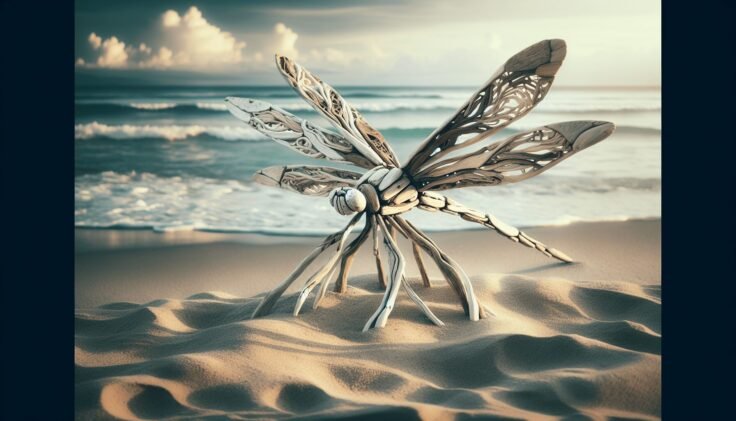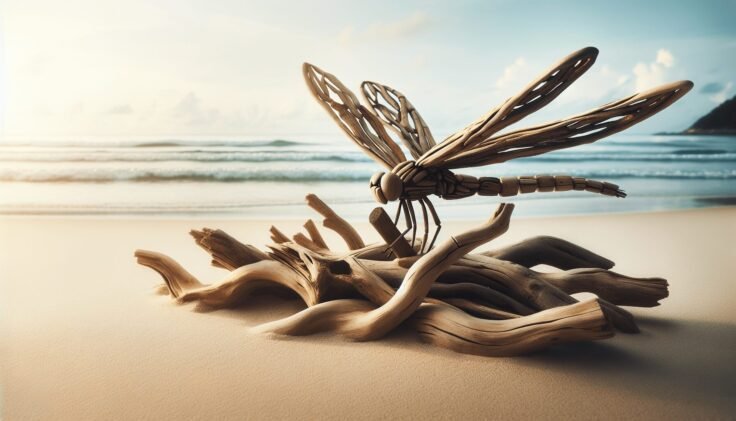Have you ever stumbled upon a piece of driftwood washed up on the shore and wondered about its journey or potential as a piece of art? The idea of creating something from nature, such as a driftwood dragonfly, is both intriguing and rewarding. This article will lead you through the world of crafting with driftwood, with a particular focus on fashioning a dragonfly. Whether you are a seasoned artist or a beginner with a passion for DIY projects, this guide is for you.
What is Driftwood?
Driftwood is a fascinating piece of nature’s artistry. It refers to wood that has been washed ashore by the action of tides, winds, and waves. Once a part of a tree, it has weathered the elements and found a new life on beaches or along the banks of rivers and lakes. The unique shapes and textures of driftwood make it a favorite medium for artists and hobbyists.
The Journey of Driftwood
Driftwood embarks on an incredible journey from forest to ocean and back to land, shaped by natural forces. As a tree ages, its branches break and fall into waterways, beginning a long voyage. During this journey, the wood is tossed and turned by waves, polished by sand, and bleached by sunlight, resulting in its smooth and weathered appearance.
Why Craft with Driftwood?
Crafting with driftwood connects you to nature, allowing creativity to flow through your hands just as the tides shaped the wood. It’s an eco-friendly and sustainable material, giving you a chance to recycle what nature has already beautifully primed.
The Artistic Appeal
The unique forms and textures of driftwood encourage creativity. No two pieces are alike, offering endless possibilities for artistic expression. It’s like piecing together a puzzle where each piece is unique in its imperfections and beauty.

Understanding the Dragonfly Symbolism
Before diving into the crafting process, it’s essential to understand why dragonflies are such popular subjects in art. Dragonflies symbolize change, transformation, adaptability, and self-realization in various cultures. They are seen as a symbol of maturity and depth of character, often reflecting a change in perspective.
The Metamorphosis
The dragonfly’s life cycle, from nymph to beautiful winged adult, is a perfect representation of transformation. By crafting this creature, you are not just creating art but also embracing the deeper symbolism of growth and change.
Preparing for Your Project
Now that you understand the fascinating journey and symbolism of both driftwood and dragonflies, it’s time to prepare for your project. Proper preparation can turn your crafting experience from enjoyable to extraordinary.
Collecting Driftwood
Head to your local beach or riverbank to begin collecting driftwood. Look for pieces that inspire you, whether because of their texture, shape, or size. Remember to gather a variety of pieces for maximum flexibility during assembly.
Tools and Supplies Needed
Having the right tools and supplies is crucial for crafting a driftwood dragonfly efficiently. Here’s a simple checklist:
| Tools | Supplies |
|---|---|
| Saw or pruning cutter | Driftwood pieces |
| Sandpaper | Non-toxic wood glue |
| Drill with small bits | String or wire for hanging |
| Paintbrush (optional) | Paints or varnish (optional) |
Ensure you have a suitable workspace, as things can get messy. A well-lit area with a spacious table is ideal for organizing your materials and working comfortably.

Crafting Your Driftwood Dragonfly
With everything gathered, it’s time to start assembling your dragonfly. This process is where your imagination takes flight.
Designing the Frame
Lay out your driftwood pieces and start visualizing the dragonfly’s body and wings. Typically, a larger, elongated piece will serve as the body. Arrange smaller, more symmetrical pieces for the wings, maintaining a balance on each side.
Assembling the Body
Once satisfied with your frame, begin attaching the driftwood pieces using wood glue. For added stability, you might want to reinforce connections with screws or small nails if necessary.
Creating the Wings
The wings of a dragonfly are its standout feature. Consider incorporating paint or varnish to highlight natural details. If painting, remember to use a light hand to preserve the driftwood’s natural beauty. You can create intricate patterns to mimic the delicate vein structures found on real dragonfly wings if desired.
Adding Finishing Touches
After constructing your driftwood dragonfly, it’s time to add the final details that make it your own.
Decorating Your Creation
Adding decorative elements like beads or colored strings can enhance your dragonfly. Consider tying strings around the middle where the wings meet or using a spot of paint to highlight the eyes or wing details.
Varnishing
To protect your creation from the elements and enhance its appearance, apply a coat of clear varnish. This step is optional but recommended, especially if you plan to display your dragonfly outdoors.
Inspiration and Ideas
Creating a driftwood dragonfly can be just the beginning. Here are additional project ideas that can expand your driftwood crafting adventures:
Driftwood Sculptures
Beyond dragonflies, driftwood can be molded into various sculptures, such as horses, fish, or even abstract art. The possibilities are endless, only limited by your imagination and the pieces of driftwood you collect.
Windchimes and Mobiles
Consider using leftover driftwood to create wind chimes or mobiles. These can feature driftwood combined with shells or sea glass, making a beautiful musical accessory to your porch or garden.
Caring for Driftwood Art
Once your driftwood project is complete, caring for it ensures it remains beautiful for years to come. Here’s how to maintain and protect your art:
Indoor Display
When displaying your driftwood dragonfly indoors, keep it away from areas with high humidity or direct sunlight. This will prevent the driftwood from warping or bleaching further.
Outdoor Display
For outdoor displays, it’s essential to seal the driftwood with a durable outdoor varnish. You might need to reapply this sealant annually to maintain its protection against weather conditions.
Benefits of Driftwood Art
Crafting with driftwood offers multiple benefits beyond the creation of beautiful art.
Environmental Impact
Using driftwood for art reduces waste and supports environmental conservation. It’s a form of recycling that doesn’t involve the emission of harmful materials.
Therapeutic and Relaxing
Engaging in driftwood artistry can be a calming and therapeutic activity. The process of sorting, designing, and assembling the pieces allows for meditative focus and stress relief.
Conclusion
Creating a driftwood dragonfly is both a meaningful and rewarding endeavor. Not only does it allow you to tap into your creativity, but it also aligns with environmental consciousness and personal reflection. Your finished piece will not only be a conversation starter but a symbol of change and transformation. You’ve taken nature’s castaway and elevated it into an art form to cherish. Enjoy the process, and let your driftwood artwork inspire both you and those around you.
Remember, the beauty of driftwood art comes from its unique properties, where every piece embodies unpredictability and beauty forged by nature’s hand. Your personal touch on a driftwood dragonfly is bound to be a masterpiece that holds the essence of both natural and creative transformation.